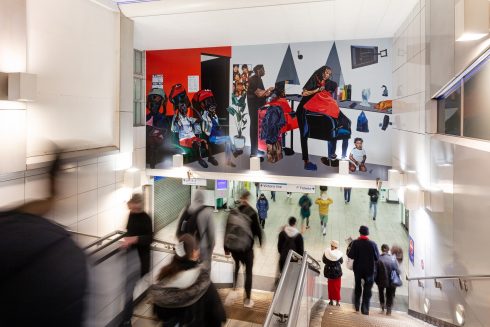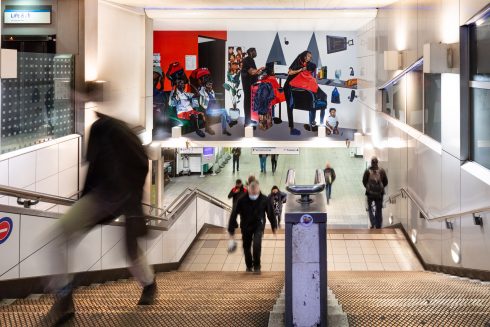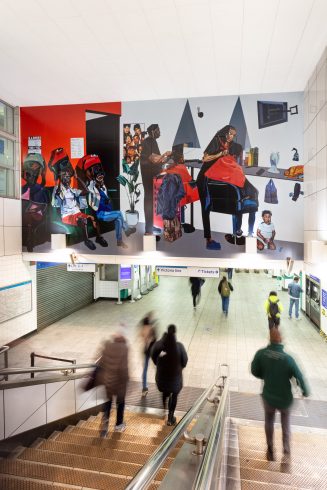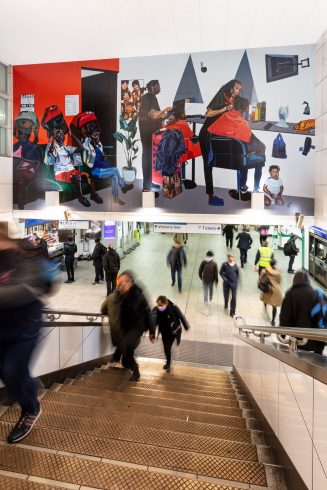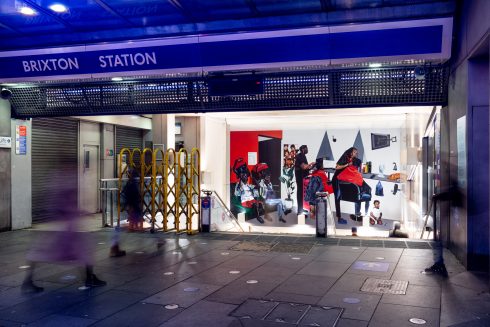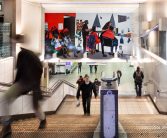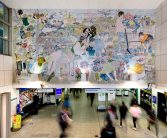Art on the Underground presented 5 more minutes, a new large-scale public commission at Brixton Underground station by London-based artist Joy Labinjo on view from November 2021 – November 2022. Drawing on her personal experiences of growing up in the UK with British-Nigerian heritage, Labinjo’s commission explores ideas of memory and belonging, and the significance of the hair salon as a centre of community in both the artist’s personal experience as well as in wider Black British female culture.
This work was the fifth in a series of commissions at Brixton station, following on from Helen Johnson, Denzil Forrester, Aliza Nisenbaum and Njideka Akunyili Crosby. The programme invites artists to respond to the diverse narratives of the local murals painted in the 1980s, the rapid development of the area and the wider social and political history of mural making.
For her commission, 5 more minutes, Labinjo depicted the interior of an imagined hair salon, an amalgamation of the spaces that the artist has visited over her life. The scene represents how the salon might look on a Saturday morning, with women and children of different generations gathered and interacting together, including recognisable and nostalgic details from the salon’s interior. The composition of the painting, brought to life using a vivid palette of colours, originates from the Labinjo’s lived experience, using images from family albums, online and historical sources, as well as from memory. Hair salons are a central part of the Afro-Caribbean community in Brixton. They have endured significant changes to the local area and continue to play an essential role.
Labinjo’s commission is rooted in the fabric of Brixton’s vibrant and diverse communities. Throughout her life, Labinjo would travel to Brixton specifically to get her hair done and, for the artist, the area’s hair salons evoke a strong sense of identity and emotional connection, exemplifying the strength of Brixton’s local community. The artist portrays the intimacy of the space by showing the conversations and relationships between women, bringing this Black British female experience to the fore. By depicting the smells, sounds and textures of the salon, she evokes a sense of place, enabling viewers to imagine themselves there. At its core, the commission is a celebration of Black female culture.
Joy Labinjo’s large-scale figurative paintings often depict intimate scenes of historical and contemporary life, both real and imagined. The figures are often based on personal and archival imagery that include family photographs, found images and historical material. She explores themes including but not limited to identity, political voice, power, Blackness, race, history, community and family, and their role in contemporary experience.
Joy Labinjo, artist, said: ‘I am delighted to create this work and it is a homecoming of sorts. Brixton is where I have worked for the past few years and visited my entire life. Its vibrancy and people inspire me daily and have done for many years. As soon as you get out of the station, you know you’ve arrived: the smell of incense; the buskers; the street raconteurs; the fashionable looks; there’s swagger, charisma and thought all around. It’s irresistible. I wanted to make work that reflects not only my own lived experiences but other Black women in London and in the UK. In a city undergoing gentrification and, in a country, in spite of recent discourses, still sceptical of race, immigration and Black culture, the beauty of Brixton needs to be celebrated and protected. It is a living and breathing memory and experience – containing a history and present we can and should all call our own.’
Eleanor Pinfield, Head of Art on the Underground, stated: ‘Joy Labinjo continues Art on the Underground’s exploration of contemporary responses to muralism for Brixton station. This imagined scene uses the everyday intimacy of the hair salon as the foundation for a visual representation of Labinjo’s local community, celebrating Black British female culture. Labinjo has combined her personal experience with memories and reflection of the area to create this vibrant work which will be enjoyed by millions of people using the station.’
